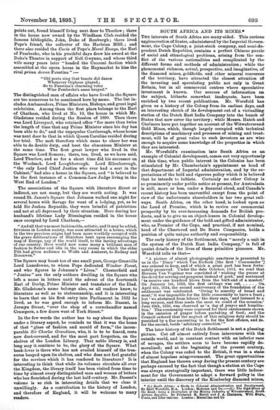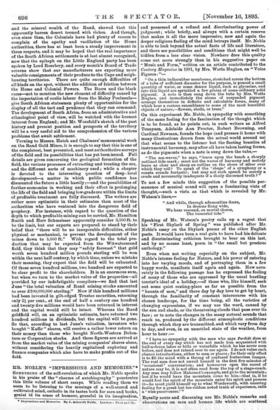SOUTH AFRICA. AND ITS MINES.*
THE interests of South Africa are many-sided. This curious.
agglomeration of States, administered by the Imperial Govern- ment, the Cape Colony, a joint-stock company, and semi-de- pendent Dutch Republics, contains a perfect Chinese puzzle of social and ethnological problems, arising from the con- flict of the various nationalities and complicated by the different forms and methods of administration ; while the phenomenal richness, actual, prospective, and imaginative, of the diamond mines, goldfields, and other mineral resources. of the territory, have attracted the closest attention of the investing and speculating public not only in Great Britain, but in all commercial centres where speculative investment is known. Our sources of information on the subject, hitherto somewhat inadequate, have been enriched by two recent publications. Mr. Worefold has given us a history of the Colony from its earliest days, and an interesting sketch of its development out of a victualling station of the Dutch East India Company into the bunch of States that now cover the territory ; while Messrs. Hatch and Chalmers have put together an account of the Witwatersrand Gold Mines, which, though largely occupied with technical descriptions of machinery and processes of mining and treat- ment, will be of great value to such investors as are wise. enough to acquire some knowledge of the properties in which they are interested.
Mr. Worsfold's examination into South Africa as an example of Colonial development, comes out very opportunely at this time, when public interest in the Colonies has been stimulated by Mr. Chamberlain's appointment as head of that department of Imperial administration, and by the ex- pectations of the bold and vigorous policy which it is believed that he intends to initiate. Certainly no other Colony is
so prominently under public notice at present, for Australasia. is still, more or less, under a financial cloud, and Canada's,
recent history has been uneventful except from the point of view of the unfortunate shareholders in her two great rail-
ways. South Africa, on the other hand, is looked upon as-
the Land of Promise, which is to revive our commercial prosperity by its ever-increasing demands for British pro- ducts, and is to give us an object-lesson in Colonial develop- ment under the guidance of the bold and gifted administrator, who, as Premier of the Cape, and practical, if not nominal, head of the Chartered and De Beers Companies, holds a position of quite unique authority and responsibility.
The early history of the Settlement, then "merely a unit in the system of the Dutch East India Company," is full of quaint details of the lives of these primitive pioneers. Mr.. Worsfold tells us that-
" A picture of almost photographic exactness is presented to us in the 'Diary' which Van Riebeck [the first Commander '] was ordered to keep, and of which a great part has been fortu- nately preserved. Under the date October, 1652, we read that Herman Van Vogslaar was convicted of wishing the purser at the devil for serving out penguins instead of pork, and sentenced
te receive one hundred blows from the butt-end of a musket.'
On January let, 1653, the first cabbage was cut On, April 6th, 1654, the second anniversary of the foundation of the-
settlement was celebrated. Owing to scarcity of bread and meat,' it was impossible for the little community to have a feast r. but' we abstained from labour,' the diary says, ' and listened to a long sermon, and thus made the most we could of the occasion.' June 29th, 1656, was observed as 'a day of prayer and humilia- tion.' The community were reproved for their carelessness shown in the omission of prayer before partaking of food ; and the- Council ordered that the neglect of this religious duty should be punished by a fine amounting to is. for the first offence, and 2e. for the second, beside arbitrary correction.'" The later history of the Dutch Settlement is not a pleasing
picture. Cut off almost entirely from intercourse with the outside world, and in constant contact with an inferior race of savages, the settlers seem to have become rapidly de- moralised; and at the beginning of the present century,.
when the Colony was ceded to the British, it was in a state- of almost hopeless misgovernment. The great opportunities- that England has thrown away during the present century are. perhaps excused by the fact that though a station at the Cape was always strategically important, there was little induce- ment for the Government to adopt a forward policy in the interior until the discovery of the Kimberley diamond mines,
• (1.) South Africa: a Study in Colonial Administration and Development. By Basil Worsfold, M.A. London: Methuen and Co.—(2.) The Gip-Minas of the Rand: being a Description of the Mining Industry of Witwatersrand, South, African Republic. By Frederick H. Hatch and J. A. QA1MerIA With MaPse Plans, and Illwrrations. London: Macmillan and go
and the mineral wealth of the Rand, showed that this apparently barren desert teemed with riches. And though, even since then, the Colonials have had plenty of reason to complain of the apathy and vacillation of the Home authorities, there has at least been a steady improvement in these respects, and it may be hoped that the real importance of the South African settlements is at last almost recognised, now that the epitaph on the Little England party has been spoken by Lord Rosebery, and every month's Board of Trade returns show that our manufacturers are exporting more valuable consignments of their produce to the Cape and neigh- bouring territories. There are quite enough difficulties of all kinds on the spot, without the addition of friction between the Home and Colonial Powers. The Boers and the black races—not to mention the new element of difficulty caused by the importation of coolie labour from the Malay Peninsula— give South African statesmen plenty of opportunities for the display of all the tact and prudence that they can command. The development of South Africa, from an administrative and ethnological point of view, will be watched with the keenest interest from England; and Mr. Worsfold's sketch of the past history and present position and prospects of the territory will be a very useful aid to the comprehension of the various problems that await settlement.
Turning to Messrs. Hatch and Chalmers' monumental work on the Rand Gold Mines, it is enough to say that this is one of the completest, best presented, and most authoritative surveys of the field and its possibilities that has yet been issued. Full details are given concerning the geological formation of the field, the various processes of extracting and treating the ore, and the different sorts of machinery used ; while a chapter is devoted to the interesting question of deep -level development—a matter in which public confidence has discounted the future a little hastily ;—and the possibilities of further economies in working and their effect in prolonging the life of the field and bringing low-grade ore within the limits of profitable treatment are f ally discussed. The writers are rather more optimistic in their estimates than most of the authorities who have ventured into the dangerous field of prophecy. For instance, with regard to the question of the depth to which profitable mining can be carried, Mr. Hamilton Smith and Herr Schmeisser apparently consider 3,500 ft. to be the limit, but our experts are prepared to stand by their belief that "there will be no insuperable difficulties, either physical or mechanical, to prevent the development of the mines down to 5,000 ft." With regard to the total pro- duction that may be expected from the Witwatersrand field, they think that they may "safely forecast" that gold worth seven hundred million pounds sterling will be won within the next half-century, by which time, unless we mistake their meaning, they expect that the field will be exhausted. Of these seven hundred millions, two hundred are expected to be clear profit to the shareholders. It is an enormous sum, but when we turn to the market value of the properties—all provided by our indefatigable compilers—we find that last June "the total valuation of Rand mining stocks amounted to over £100,000,000 sterling." Now if this hundred millions bad been invested in gilt-edged Trustee securities, returning only 21 per cent., at the end of half a century one hundred and twenty-five millions would have been returned in interest and the capital would still be intact. Whereas the Rand goldfield will, on an optimistic estimate, have returned two hundred millions in dividends, but the capital will be gone. So that, according to last Jane's valuation, investors who bought " Kaffir " shares, will receive a rather lower return on their money than those who bought North-Western Deben- ture or Corporation stocks. And these figures are arrived at from the market value of the mining companies' shares alone, without considering the heavily capitalised exploring and finance companies which also have to make profits out of the field.



















































 Previous page
Previous page